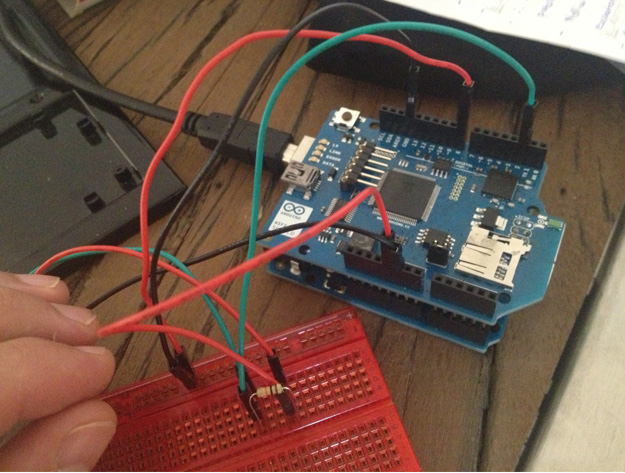Motion Sensor
Feed ID: 1141235821
API Key: nctiAubtotiIXTrpm4L7RAOvQbl5srAkOqCSQO8t7MG3PqrP
/*
##Xively WiFi Sensor Tutorial##
This sketch is designed to take sensors (from photocell) and upload the values to Xively
at consistant intervals. At the same time it gets a setable value from Xively to adjust the brigthness
of an LED. This sketch is reusable and can be adapted for use with many different sensors.
Derived from Xively Ardino Sensor Client by Sam Mulube.
By Calum Barnes 3-4-2013
BSD 3-Clause License – [http://opensource.org/licenses/BSD-3-Clause]
Copyright (c) 2013 Calum Barnes
*/
#include
#include
#include
#include
char ssid[] = “awesome”; // your network SSID (name)
//char pass[] = “67101870”; // your network password (use for WPA, or use as key for WEP)
//int keyIndex = 0; // your network key Index number (needed only for WEP)
int status = WL_IDLE_STATUS;
// Your Xively key to let you upload data
char xivelyKey[] = “nctiAubtotiIXTrpm4L7RAOvQbl5srAkOqCSQO8t7MG3PqrP”;
//your xively feed ID
#define xivelyFeed 1141235821
//datastreams
char sensorID[] = “MotionSensor”;
char ledID[] = “LEDarray”;
// Analog pin which we’re monitoring (0 and 1 are used by the Ethernet shield)
#define MotionSensor 2
//led connected pin
#define ledPin 8
// Define the strings for our datastream IDs
XivelyDatastream datastreams[] = {
XivelyDatastream(sensorID, strlen(sensorID), DATASTREAM_FLOAT),
XivelyDatastream(ledID, strlen(ledID), DATASTREAM_FLOAT),
};
// Finally, wrap the datastreams into a feed
XivelyFeed feed(xivelyFeed, datastreams, 2 /* number of datastreams */);
WiFiClient client;
XivelyClient xivelyclient(client);
void printWifiStatus() {
// print the SSID of the network you’re attached to:
Serial.print(“SSID: “);
Serial.println(WiFi.SSID());
// print your WiFi shield’s IP address:
IPAddress ip = WiFi.localIP();
Serial.print(“IP Address: “);
Serial.println(ip);
// print the received signal strength:
long rssi = WiFi.RSSI();
Serial.print(“signal strength (RSSI):”);
Serial.print(rssi);
Serial.println(” dBm \n”);
}
void setup() {
// put your setup code here, to run once:
Serial.begin(9600);
//pin setup
pinMode(MotionSensor, INPUT);
pinMode(ledPin, OUTPUT);
Serial.println(“Starting single datastream upload to Xively…”);
Serial.println();
// attempt to connect to Wifi network:
while ( status != WL_CONNECTED) {
Serial.print(“Attempting to connect to SSID: “);
Serial.println(ssid);
status = WiFi.begin(ssid);
// wait 10 seconds for connection:
delay(5000);
}
Serial.println(“Connected to wifi”);
printWifiStatus();
}
void loop() {
int pirVal = digitalRead(MotionSensor);
if(pirVal == LOW){ //was motion detected
Serial.println(“Motion Detected”);
digitalWrite(ledPin, HIGH); // turn LED ON
delay(7000);
}
else {
digitalWrite(ledPin, LOW); // turn LED OFF
delay(3000);
}
// //adjust LED level. set from Xively
// int getReturn = xivelyclient.get(feed, xivelyKey); //get data from xively
// if(getReturn > 0){
// Serial.println(“LED Datastream”);
// Serial.println(feed[1]);
// }else Serial.println(“HTTP Error”);
// //write value to LED – change brightness
// int level = feed[1].getFloat();
// if(level < 0){
// level = 0;
// }else if(level > 255){
// level = 255;
// }
// //actually write the value
// digitalWrite(ledPin, level);
///////////////////////////////////////////////////////
//read sensor values
int sensorValue = digitalRead(MotionSensor);
datastreams[0].setFloat(sensorValue);
//print the sensor valye
Serial.print(“Sensor value “);
Serial.println(datastreams[0].getFloat());
//send value to xively
Serial.println(“Uploading it to Xively”);
int ret = xivelyclient.put(feed, xivelyKey);
//return message
Serial.print(“xivelyclient.put returned “);
Serial.println(ret);
Serial.println(“”);
//delay between calls
delay(15000);
}
